Hubert P. H. Shum
Continual Action Quality Assessment via Adaptive Manifold-Aligned Graph Regularization
Oct 08, 2025Abstract:Action Quality Assessment (AQA) quantifies human actions in videos, supporting applications in sports scoring, rehabilitation, and skill evaluation. A major challenge lies in the non-stationary nature of quality distributions in real-world scenarios, which limits the generalization ability of conventional methods. We introduce Continual AQA (CAQA), which equips AQA with Continual Learning (CL) capabilities to handle evolving distributions while mitigating catastrophic forgetting. Although parameter-efficient fine-tuning of pretrained models has shown promise in CL for image classification, we find it insufficient for CAQA. Our empirical and theoretical analyses reveal two insights: (i) Full-Parameter Fine-Tuning (FPFT) is necessary for effective representation learning; yet (ii) uncontrolled FPFT induces overfitting and feature manifold shift, thereby aggravating forgetting. To address this, we propose Adaptive Manifold-Aligned Graph Regularization (MAGR++), which couples backbone fine-tuning that stabilizes shallow layers while adapting deeper ones with a two-step feature rectification pipeline: a manifold projector to translate deviated historical features into the current representation space, and a graph regularizer to align local and global distributions. We construct four CAQA benchmarks from three datasets with tailored evaluation protocols and strong baselines, enabling systematic cross-dataset comparison. Extensive experiments show that MAGR++ achieves state-of-the-art performance, with average correlation gains of 3.6% offline and 12.2% online over the strongest baseline, confirming its robustness and effectiveness. Our code is available at https://github.com/ZhouKanglei/MAGRPP.
PHI: Bridging Domain Shift in Long-Term Action Quality Assessment via Progressive Hierarchical Instruction
May 26, 2025Abstract:Long-term Action Quality Assessment (AQA) aims to evaluate the quantitative performance of actions in long videos. However, existing methods face challenges due to domain shifts between the pre-trained large-scale action recognition backbones and the specific AQA task, thereby hindering their performance. This arises since fine-tuning resource-intensive backbones on small AQA datasets is impractical. We address this by identifying two levels of domain shift: task-level, regarding differences in task objectives, and feature-level, regarding differences in important features. For feature-level shifts, which are more detrimental, we propose Progressive Hierarchical Instruction (PHI) with two strategies. First, Gap Minimization Flow (GMF) leverages flow matching to progressively learn a fast flow path that reduces the domain gap between initial and desired features across shallow to deep layers. Additionally, a temporally-enhanced attention module captures long-range dependencies essential for AQA. Second, List-wise Contrastive Regularization (LCR) facilitates coarse-to-fine alignment by comprehensively comparing batch pairs to learn fine-grained cues while mitigating domain shift. Integrating these modules, PHI offers an effective solution. Experiments demonstrate that PHI achieves state-of-the-art performance on three representative long-term AQA datasets, proving its superiority in addressing the domain shift for long-term AQA.
Large-Scale Multi-Character Interaction Synthesis
May 20, 2025Abstract:Generating large-scale multi-character interactions is a challenging and important task in character animation. Multi-character interactions involve not only natural interactive motions but also characters coordinated with each other for transition. For example, a dance scenario involves characters dancing with partners and also characters coordinated to new partners based on spatial and temporal observations. We term such transitions as coordinated interactions and decompose them into interaction synthesis and transition planning. Previous methods of single-character animation do not consider interactions that are critical for multiple characters. Deep-learning-based interaction synthesis usually focuses on two characters and does not consider transition planning. Optimization-based interaction synthesis relies on manually designing objective functions that may not generalize well. While crowd simulation involves more characters, their interactions are sparse and passive. We identify two challenges to multi-character interaction synthesis, including the lack of data and the planning of transitions among close and dense interactions. Existing datasets either do not have multiple characters or do not have close and dense interactions. The planning of transitions for multi-character close and dense interactions needs both spatial and temporal considerations. We propose a conditional generative pipeline comprising a coordinatable multi-character interaction space for interaction synthesis and a transition planning network for coordinations. Our experiments demonstrate the effectiveness of our proposed pipeline for multicharacter interaction synthesis and the applications facilitated by our method show the scalability and transferability.
Using Fixed and Mobile Eye Tracking to Understand How Visitors View Art in a Museum: A Study at the Bowes Museum, County Durham, UK
Apr 28, 2025Abstract:The following paper describes a collaborative project involving researchers at Durham University, and professionals at the Bowes Museum, Barnard Castle, County Durham, UK, during which we used fixed and mobile eye tracking to understand how visitors view art. Our study took place during summer 2024 and builds on work presented at DH2017 (Bailey-Ross et al., 2017). Our interdisciplinary team included researchers from digital humanities, psychology, art history and computer science, working in collaboration with professionals from the museum. We used fixed and mobile eye tracking to understand how museum visitors view art in a physical gallery setting. This research will enable us to make recommendations about how the Museum's collections could be more effectively displayed, encouraging visitors to engage with them more fully.
FineCausal: A Causal-Based Framework for Interpretable Fine-Grained Action Quality Assessment
Mar 31, 2025Abstract:Action quality assessment (AQA) is critical for evaluating athletic performance, informing training strategies, and ensuring safety in competitive sports. However, existing deep learning approaches often operate as black boxes and are vulnerable to spurious correlations, limiting both their reliability and interpretability. In this paper, we introduce FineCausal, a novel causal-based framework that achieves state-of-the-art performance on the FineDiving-HM dataset. Our approach leverages a Graph Attention Network-based causal intervention module to disentangle human-centric foreground cues from background confounders, and incorporates a temporal causal attention module to capture fine-grained temporal dependencies across action stages. This dual-module strategy enables FineCausal to generate detailed spatio-temporal representations that not only achieve state-of-the-art scoring performance but also provide transparent, interpretable feedback on which features drive the assessment. Despite its strong performance, FineCausal requires extensive expert knowledge to define causal structures and depends on high-quality annotations, challenges that we discuss and address as future research directions. Code is available at https://github.com/Harrison21/FineCausal.
TFDM: Time-Variant Frequency-Based Point Cloud Diffusion with Mamba
Mar 17, 2025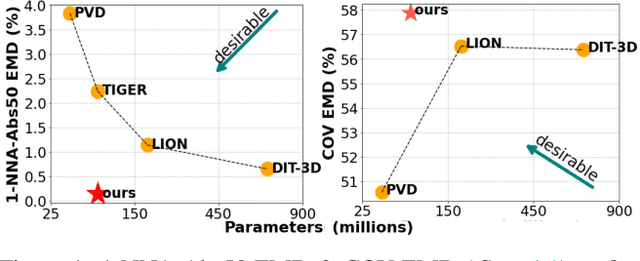



Abstract:Diffusion models currently demonstrate impressive performance over various generative tasks. Recent work on image diffusion highlights the strong capabilities of Mamba (state space models) due to its efficient handling of long-range dependencies and sequential data modeling. Unfortunately, joint consideration of state space models with 3D point cloud generation remains limited. To harness the powerful capabilities of the Mamba model for 3D point cloud generation, we propose a novel diffusion framework containing dual latent Mamba block (DM-Block) and a time-variant frequency encoder (TF-Encoder). The DM-Block apply a space-filling curve to reorder points into sequences suitable for Mamba state-space modeling, while operating in a latent space to mitigate the computational overhead that arises from direct 3D data processing. Meanwhile, the TF-Encoder takes advantage of the ability of the diffusion model to refine fine details in later recovery stages by prioritizing key points within the U-Net architecture. This frequency-based mechanism ensures enhanced detail quality in the final stages of generation. Experimental results on the ShapeNet-v2 dataset demonstrate that our method achieves state-of-the-art performance (ShapeNet-v2: 0.14\% on 1-NNA-Abs50 EMD and 57.90\% on COV EMD) on certain metrics for specific categories while reducing computational parameters and inference time by up to 10$\times$ and 9$\times$, respectively. Source code is available in Supplementary Materials and will be released upon accpetance.
BP-SGCN: Behavioral Pseudo-Label Informed Sparse Graph Convolution Network for Pedestrian and Heterogeneous Trajectory Prediction
Feb 21, 2025


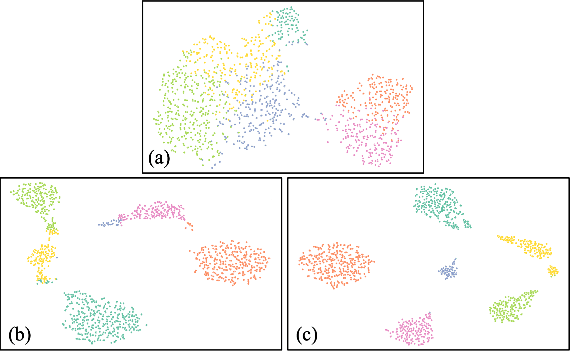
Abstract:Trajectory prediction allows better decision-making in applications of autonomous vehicles or surveillance by predicting the short-term future movement of traffic agents. It is classified into pedestrian or heterogeneous trajectory prediction. The former exploits the relatively consistent behavior of pedestrians, but is limited in real-world scenarios with heterogeneous traffic agents such as cyclists and vehicles. The latter typically relies on extra class label information to distinguish the heterogeneous agents, but such labels are costly to annotate and cannot be generalized to represent different behaviors within the same class of agents. In this work, we introduce the behavioral pseudo-labels that effectively capture the behavior distributions of pedestrians and heterogeneous agents solely based on their motion features, significantly improving the accuracy of trajectory prediction. To implement the framework, we propose the Behavioral Pseudo-Label Informed Sparse Graph Convolution Network (BP-SGCN) that learns pseudo-labels and informs to a trajectory predictor. For optimization, we propose a cascaded training scheme, in which we first learn the pseudo-labels in an unsupervised manner, and then perform end-to-end fine-tuning on the labels in the direction of increasing the trajectory prediction accuracy. Experiments show that our pseudo-labels effectively model different behavior clusters and improve trajectory prediction. Our proposed BP-SGCN outperforms existing methods using both pedestrian (ETH/UCY, pedestrian-only SDD) and heterogeneous agent datasets (SDD, Argoverse 1).
Unified Spatial-Temporal Edge-Enhanced Graph Networks for Pedestrian Trajectory Prediction
Feb 04, 2025Abstract:Pedestrian trajectory prediction aims to forecast future movements based on historical paths. Spatial-temporal (ST) methods often separately model spatial interactions among pedestrians and temporal dependencies of individuals. They overlook the direct impacts of interactions among different pedestrians across various time steps (i.e., high-order cross-time interactions). This limits their ability to capture ST inter-dependencies and hinders prediction performance. To address these limitations, we propose UniEdge with three major designs. Firstly, we introduce a unified ST graph data structure that simplifies high-order cross-time interactions into first-order relationships, enabling the learning of ST inter-dependencies in a single step. This avoids the information loss caused by multi-step aggregation. Secondly, traditional GNNs focus on aggregating pedestrian node features, neglecting the propagation of implicit interaction patterns encoded in edge features. We propose the Edge-to-Edge-Node-to-Node Graph Convolution (E2E-N2N-GCN), a novel dual-graph network that jointly models explicit N2N social interactions among pedestrians and implicit E2E influence propagation across these interaction patterns. Finally, to overcome the limited receptive fields and challenges in capturing long-range dependencies of auto-regressive architectures, we introduce a transformer encoder-based predictor that enables global modeling of temporal correlation. UniEdge outperforms state-of-the-arts on multiple datasets, including ETH, UCY, and SDD.
A Comprehensive Survey of Action Quality Assessment: Method and Benchmark
Dec 15, 2024Abstract:Action Quality Assessment (AQA) quantitatively evaluates the quality of human actions, providing automated assessments that reduce biases in human judgment. Its applications span domains such as sports analysis, skill assessment, and medical care. Recent advances in AQA have introduced innovative methodologies, but similar methods often intertwine across different domains, highlighting the fragmented nature that hinders systematic reviews. In addition, the lack of a unified benchmark and limited computational comparisons hinder consistent evaluation and fair assessment of AQA approaches. In this work, we address these gaps by systematically analyzing over 150 AQA-related papers to develop a hierarchical taxonomy, construct a unified benchmark, and provide an in-depth analysis of current trends, challenges, and future directions. Our hierarchical taxonomy categorizes AQA methods based on input modalities (video, skeleton, multi-modal) and their specific characteristics, highlighting the evolution and interrelations across various approaches. To promote standardization, we present a unified benchmark, integrating diverse datasets to evaluate the assessment precision and computational efficiency. Finally, we review emerging task-specific applications and identify under-explored challenges in AQA, providing actionable insights into future research directions. This survey aims to deepen understanding of AQA progress, facilitate method comparison, and guide future innovations. The project web page can be found at https://ZhouKanglei.github.io/AQA-Survey.
Adaptive Graph Learning from Spatial Information for Surgical Workflow Anticipation
Dec 09, 2024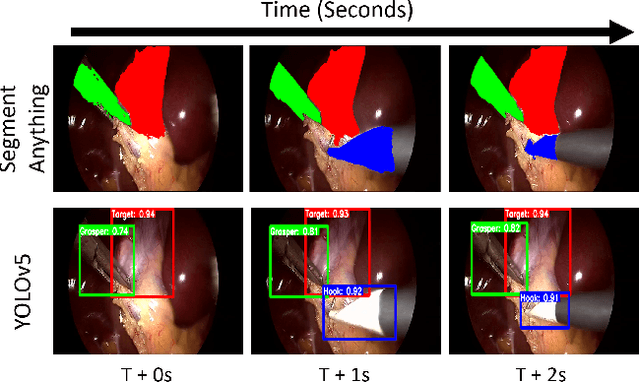
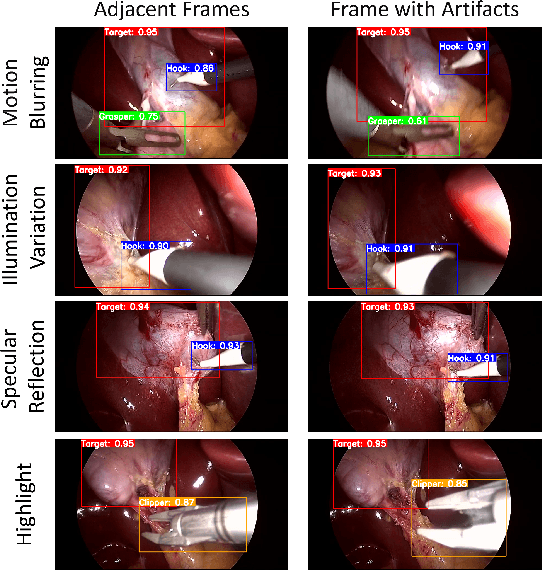
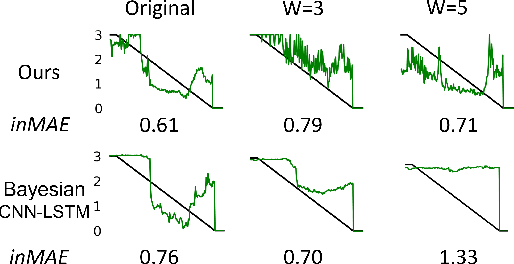
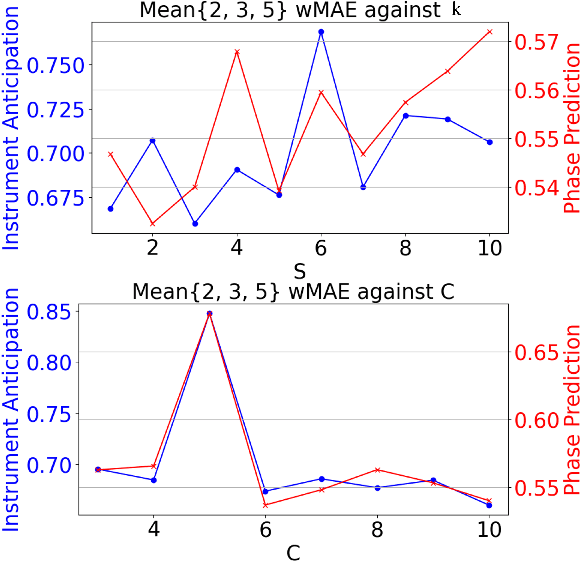
Abstract:Surgical workflow anticipation is the task of predicting the timing of relevant surgical events from live video data, which is critical in Robotic-Assisted Surgery (RAS). Accurate predictions require the use of spatial information to model surgical interactions. However, current methods focus solely on surgical instruments, assume static interactions between instruments, and only anticipate surgical events within a fixed time horizon. To address these challenges, we propose an adaptive graph learning framework for surgical workflow anticipation based on a novel spatial representation, featuring three key innovations. First, we introduce a new representation of spatial information based on bounding boxes of surgical instruments and targets, including their detection confidence levels. These are trained on additional annotations we provide for two benchmark datasets. Second, we design an adaptive graph learning method to capture dynamic interactions. Third, we develop a multi-horizon objective that balances learning objectives for different time horizons, allowing for unconstrained predictions. Evaluations on two benchmarks reveal superior performance in short-to-mid-term anticipation, with an error reduction of approximately 3% for surgical phase anticipation and 9% for remaining surgical duration anticipation. These performance improvements demonstrate the effectiveness of our method and highlight its potential for enhancing preparation and coordination within the RAS team. This can improve surgical safety and the efficiency of operating room usage.
 Add to Chrome
Add to Chrome Add to Firefox
Add to Firefox Add to Edge
Add to Edge